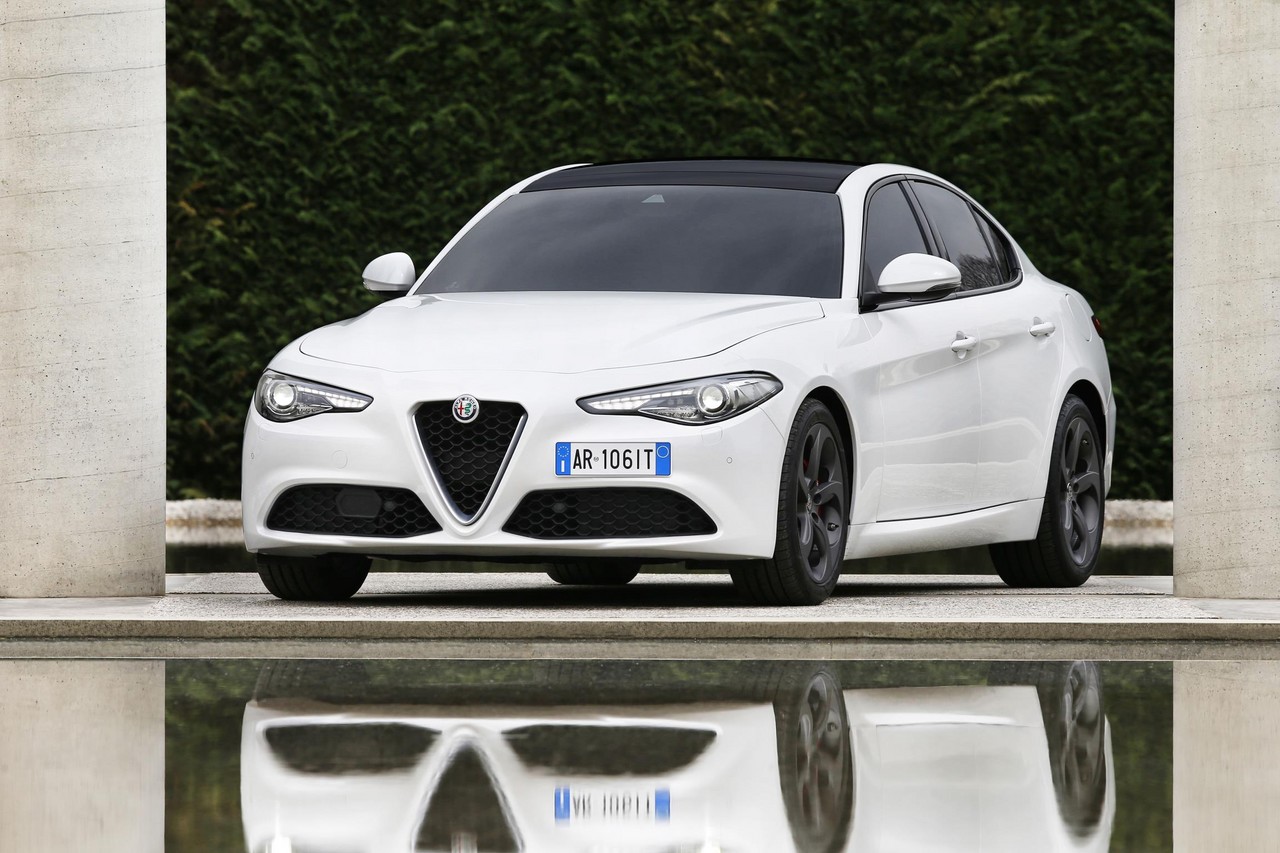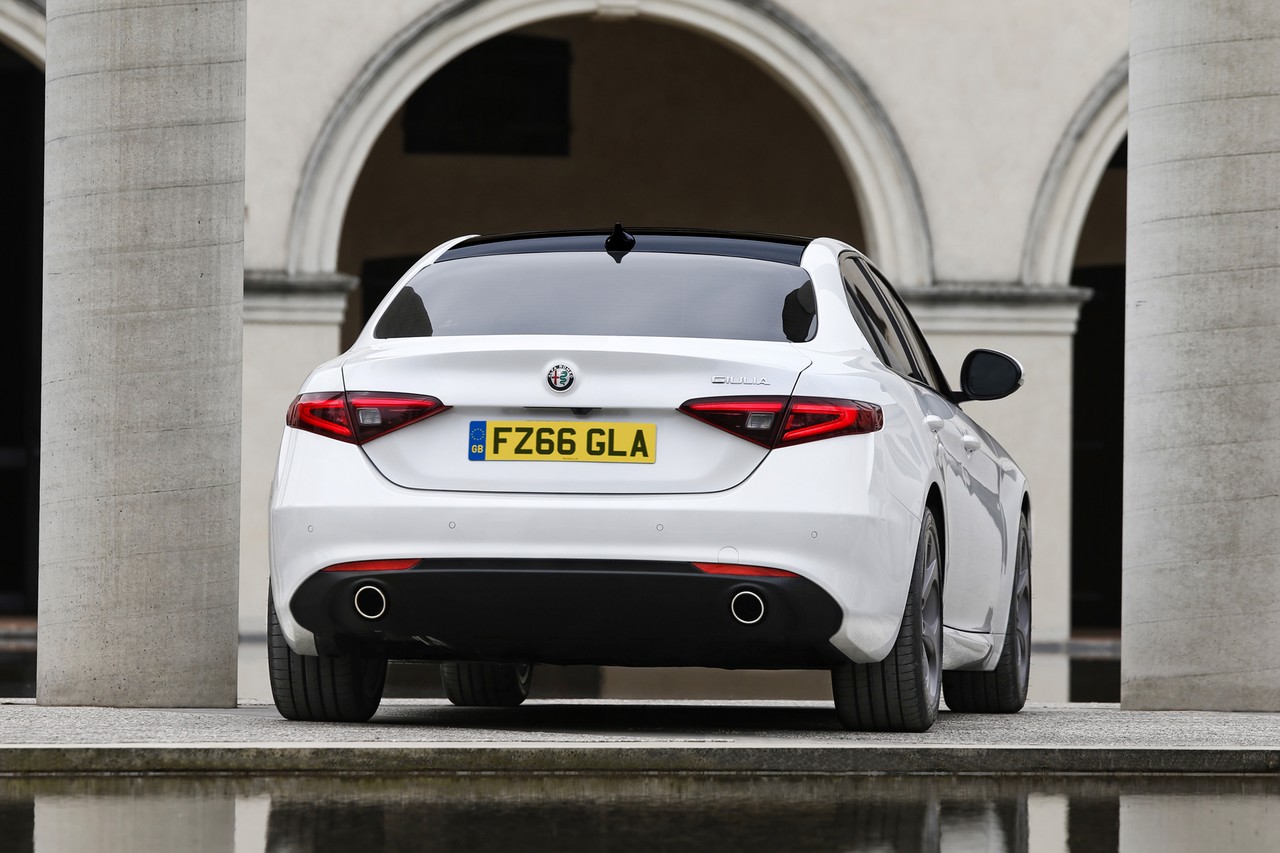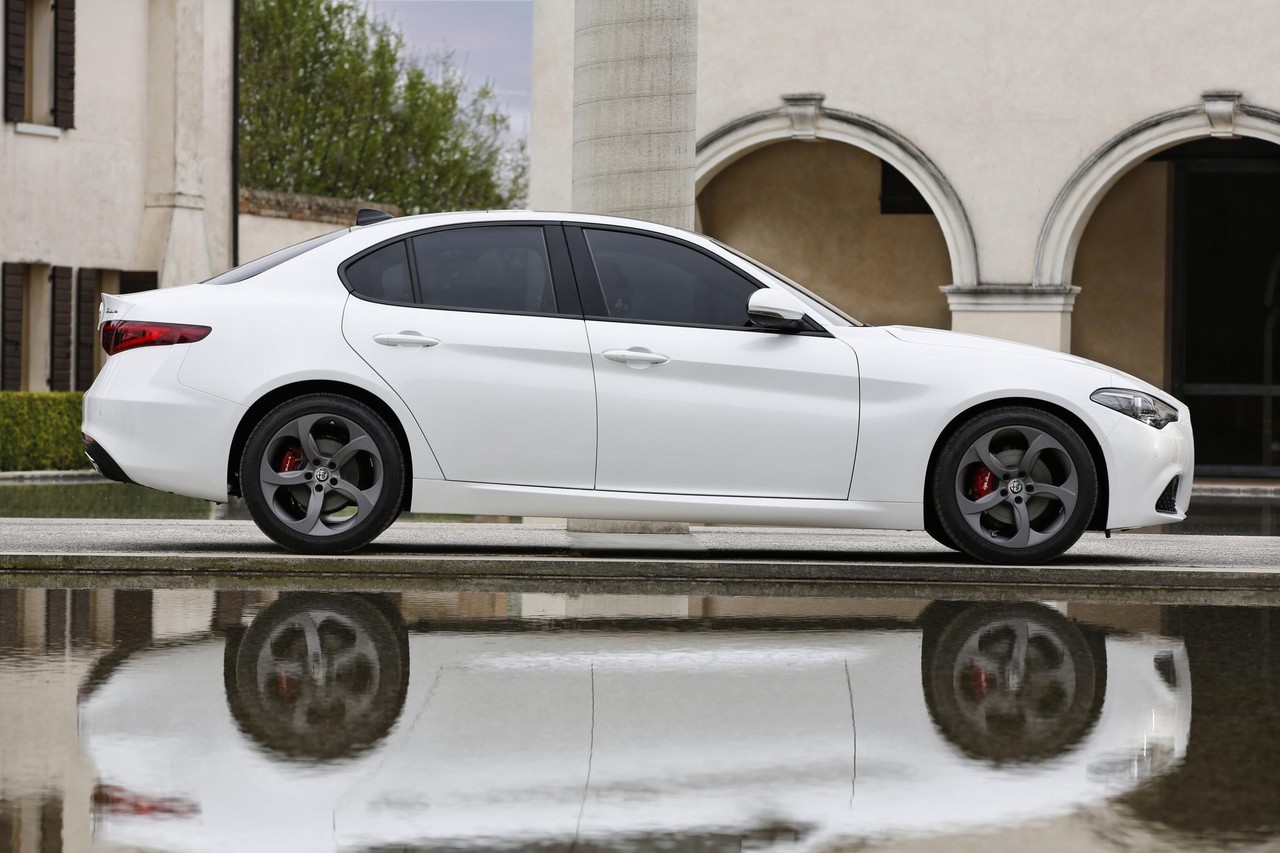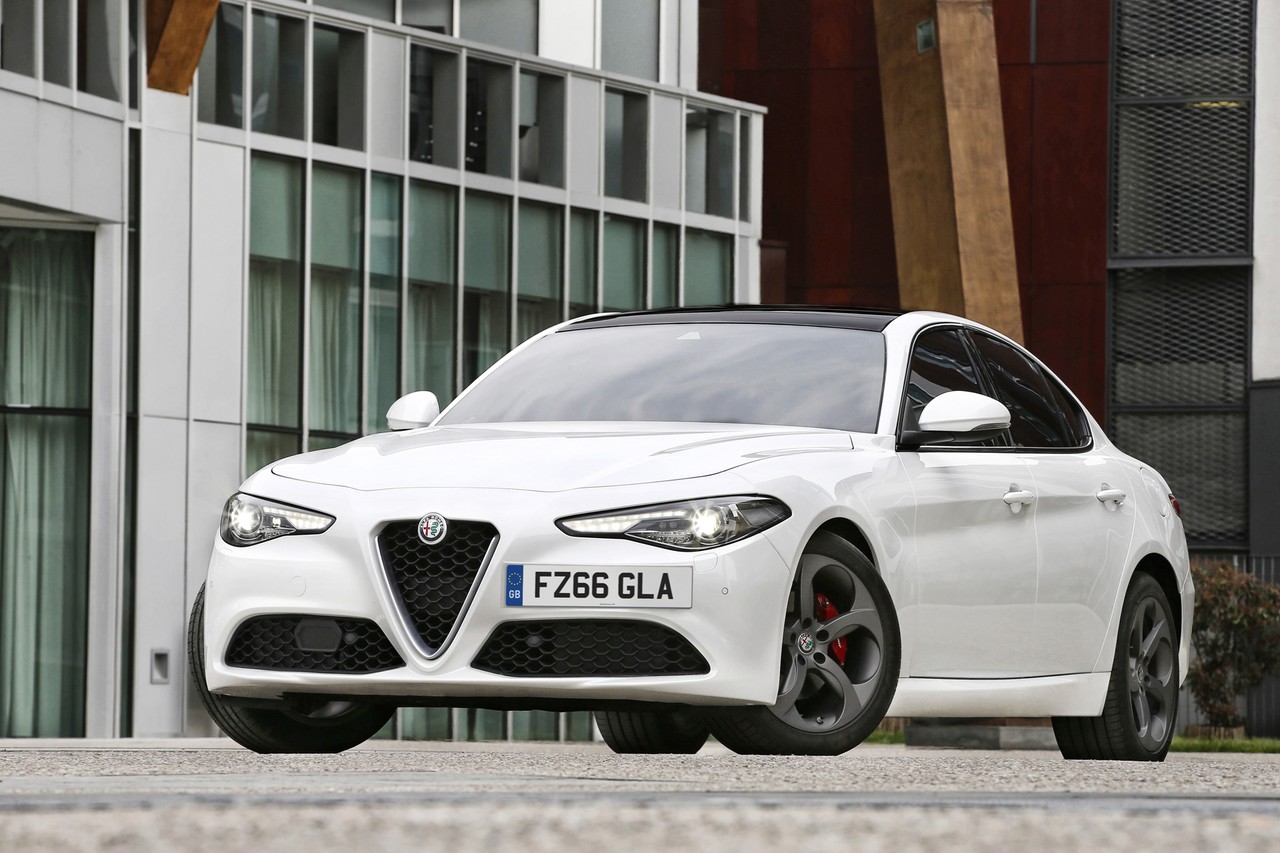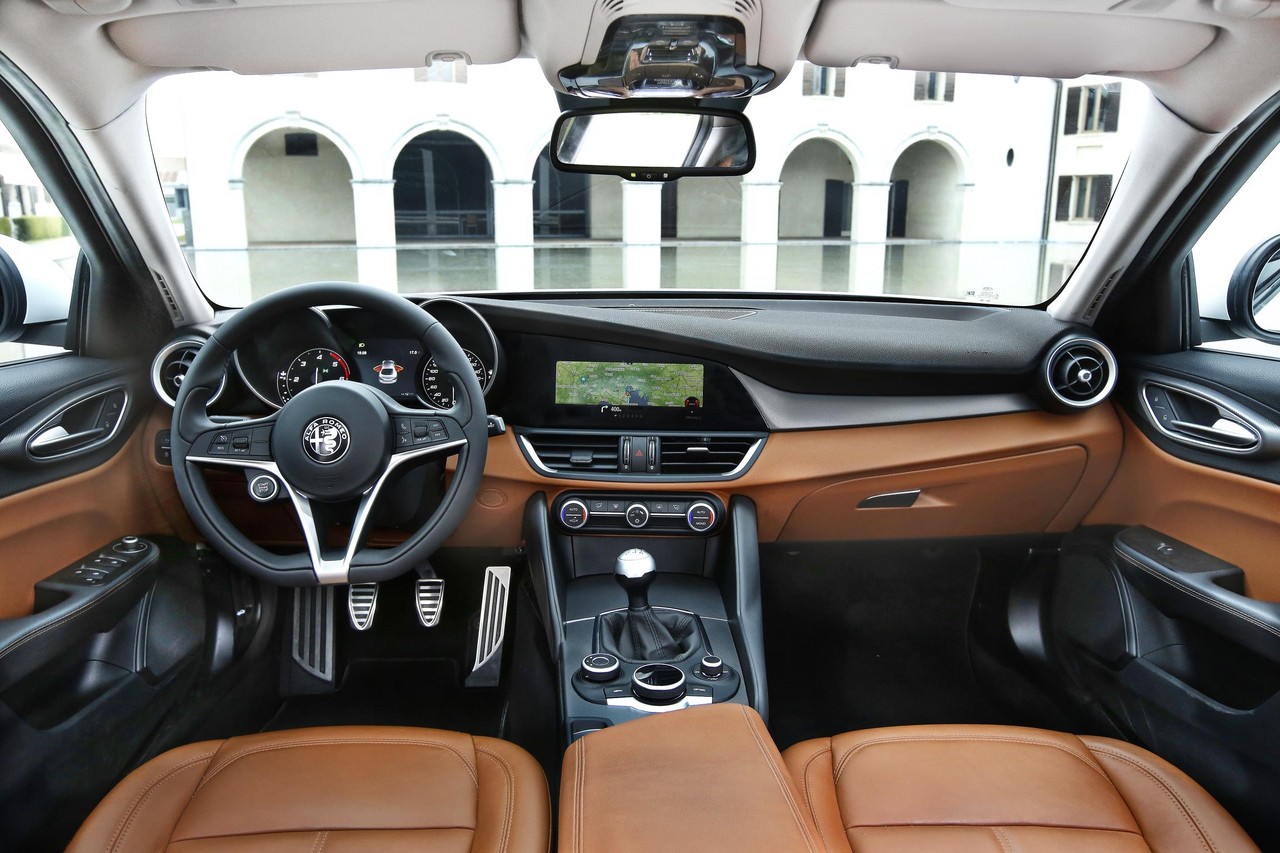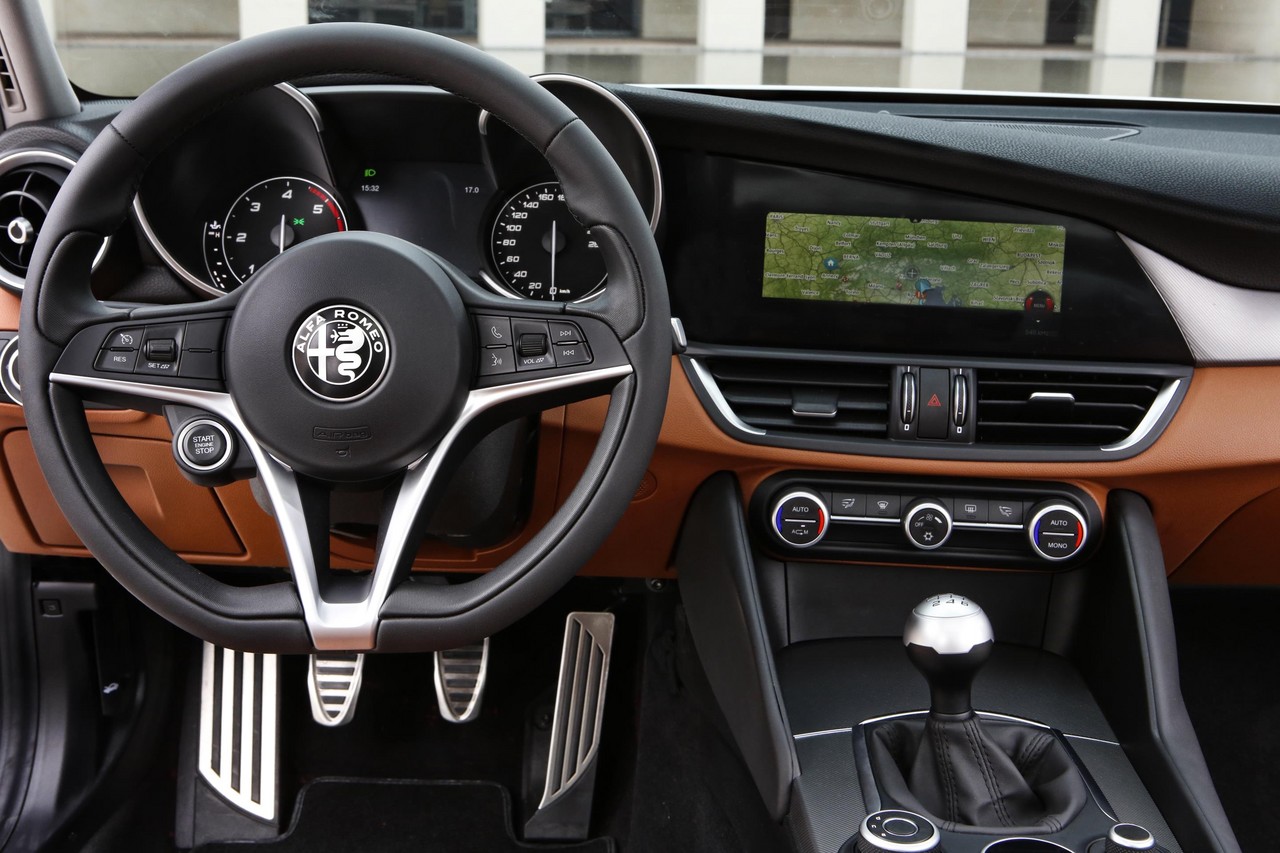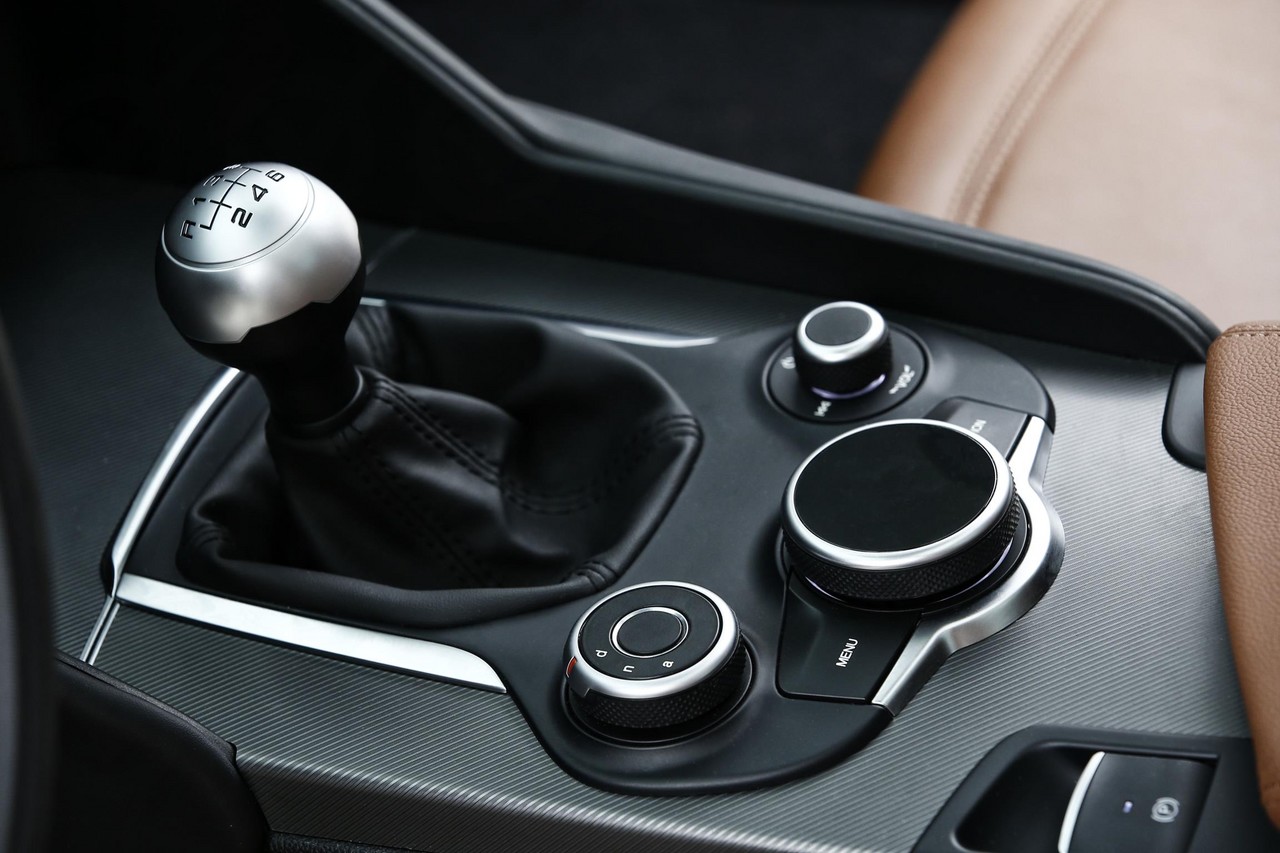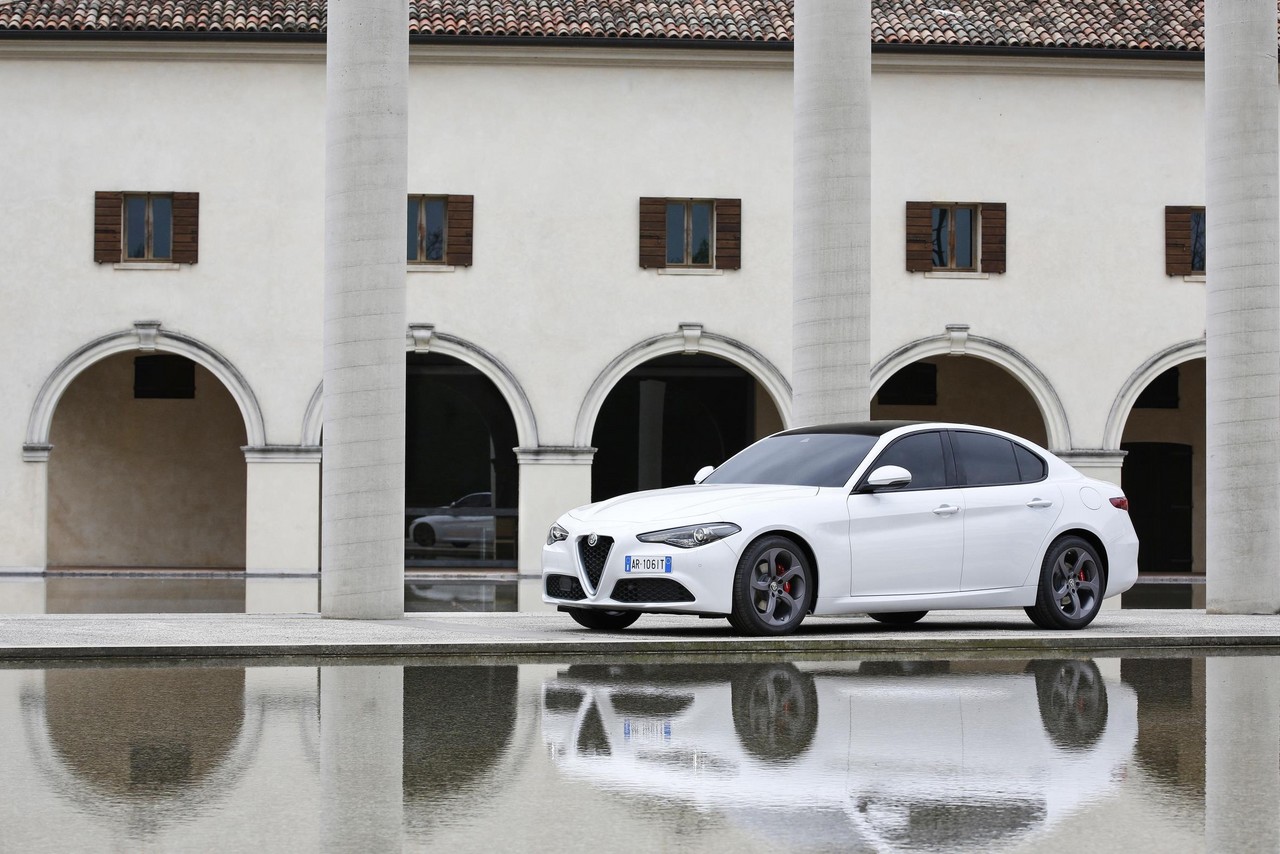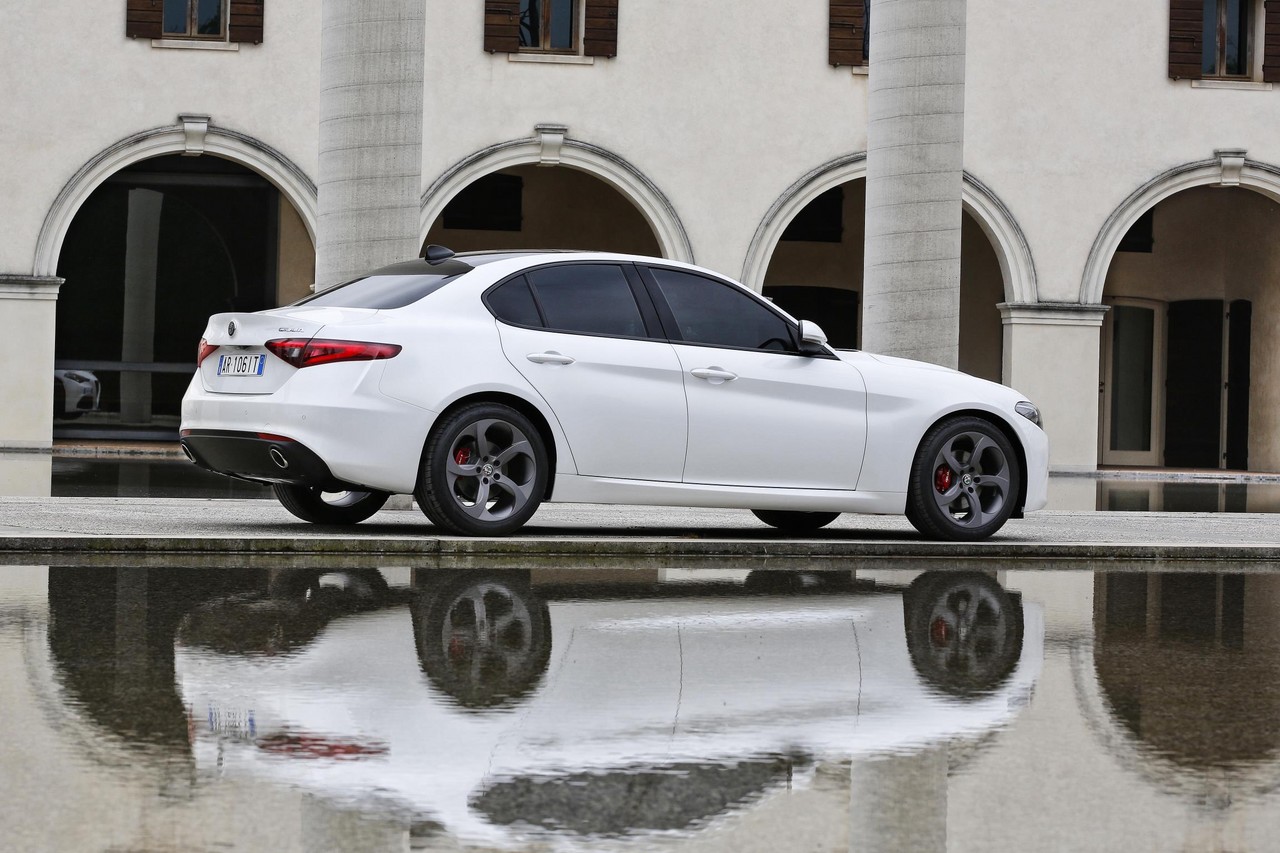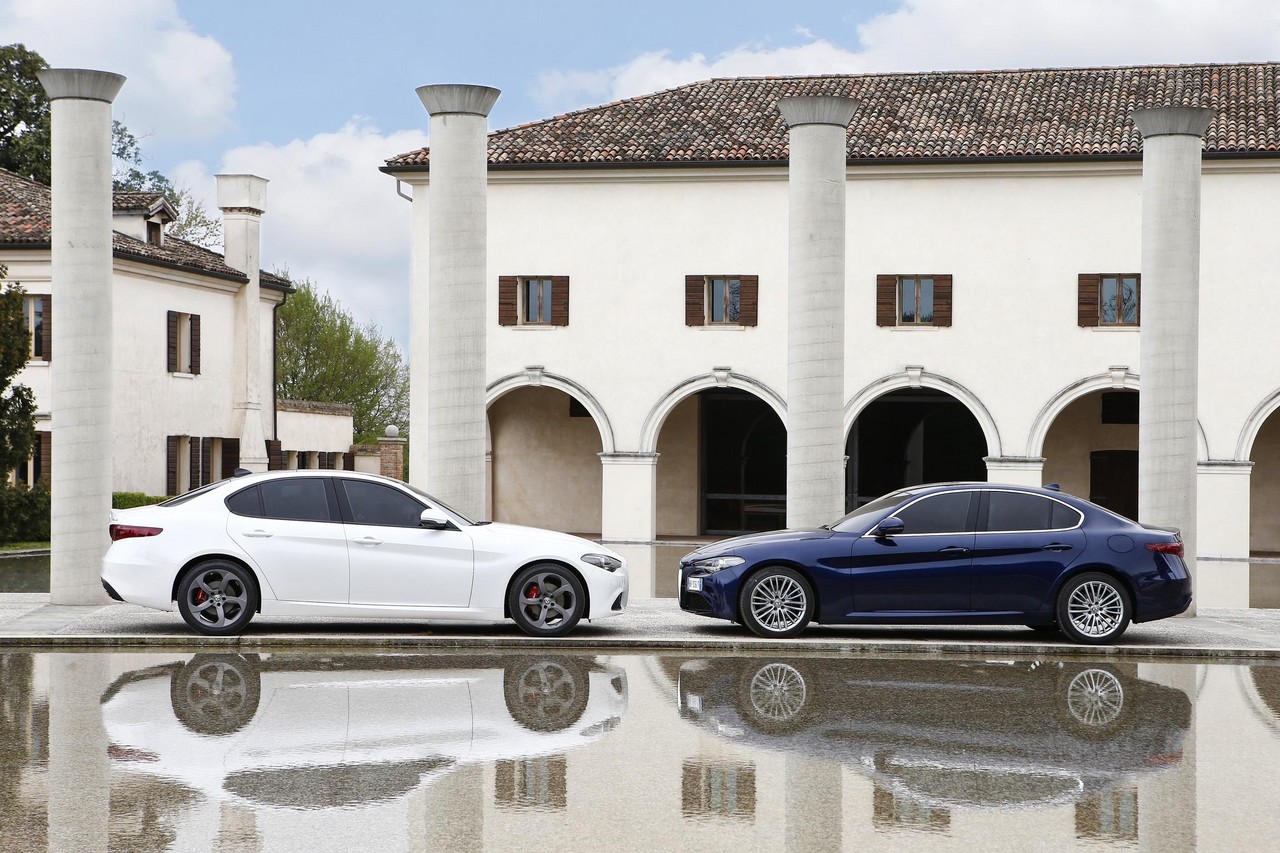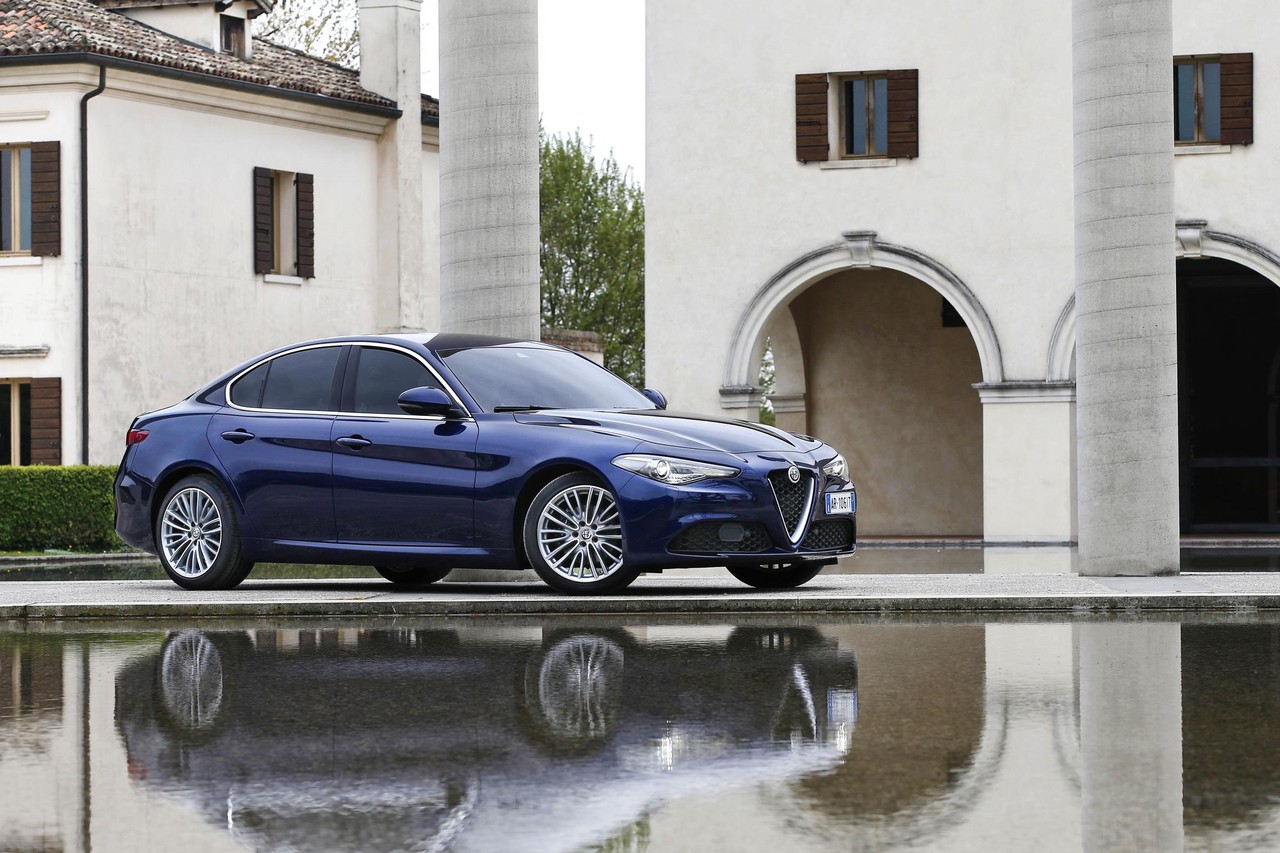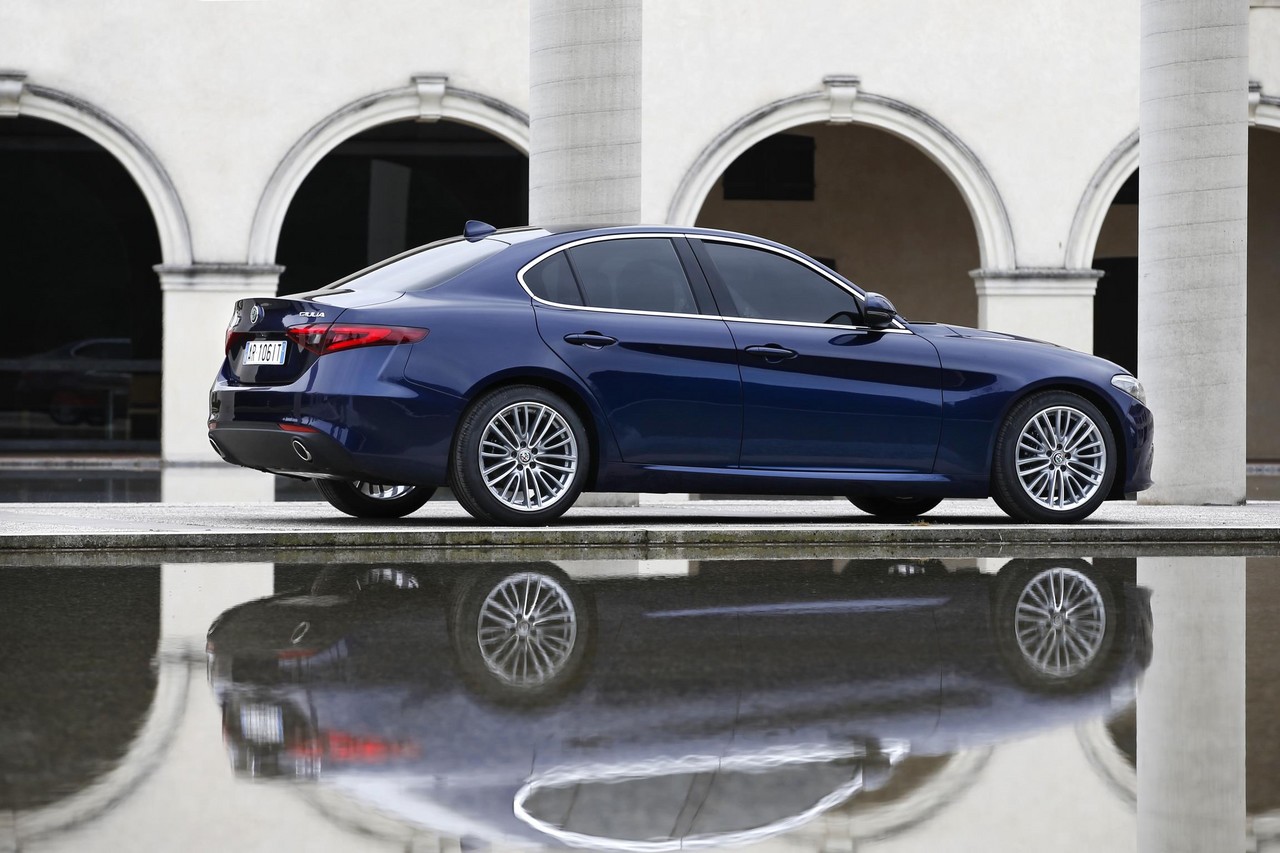
- Svelte styling
- Responsive engines
- Refined eight-speed ZF transmissions
- Quiet, well-insulated cabin
- Accomplished dynamics, though ride deteriorates on 19-inch wheels
- Pedals are skewed to right and gearshift paddles are fixed
- Front tyres skip during low-speed manoeuvres
- Steering lacks feel and the ratio is too direct
- Poor rear headroom
- Throttle is overly sensitive at low speeds
- Poor illumination from low beam headlights
- Wiper speeds ill-suited to light rain
- Cheap touchscreen, indicator and wiper stalks
- No Apple CarPlay or Android Auto smartphone integration
- Shallow boot
- High servicing costs
Overview
Commencing production in May 2016, the Alfa Romeo Giulia was a compact executive sedan that was released in Australia in February 2017. Manufactured in Cassino, Italy, the rear-wheel drive Alfa Romeo Type 952 Giulia range included turbocharged petrol and diesel engines (see table below) and four editions: standard, Super, Veloce and Quadrifoglio.
In February 2019, the Alfa Romeo Giulia range was revised as the 2.2 JTDM-2 variants were withdrawn from the Australian market.
| Variant | Edition | Engine | Trans. | Peak power | Peak torque |
|---|---|---|---|---|---|
| 2.0 MultiAir | Standard, Super |
2.0-litre turbo petrol I4 | 8sp auto (ZF 8HP50) |
147 kW at 5000 rpm | 330 Nm at 1750 rpm |
| 2.2 JTDM-2 | Super | 2.2-litre turbo diesel I4 | 8sp auto (ZF 8HP50) |
132 kW at 3750 rpm | 450 Nm at 1750 rpm |
| 2.0 MultiAir | Veloce | 2.0-litre turbo petrol I4 | 8sp auto (ZF 8HP50) |
206 kW at 5250 rpm | 400 Nm at 2250-4500 rpm |
| 2.9 V6 | Quadri- foglio | 2.9-litre F154 biturbo petrol V6 | 8sp auto (ZF 8HP75) |
375 kW at 6500 rpm | 600 Nm at 2500-5000 rpm |
Dimensions and body
The Alfa Romeo Type 952 Giulia was underpinned by Alfa Romeo’s ‘Giorgio’ rear-wheel drive architecture, which will also be used for the Alfa Romeo Stelvio SUV . Compared to the Alfa Romeo 159 , the Type 952 Giulia was 17 mm shorter (at 4643 mm), 32 mm wider (1860 mm), 14 mm taller (1436 mm) and had a 120 mm longer wheelbase (2820 mm); its boot had a capacity of 480 litres. Furthermore, the Alfa Romeo Giulia had a 50:50 front:rear weight distribution and adopted the following mass reduction measures:
- A carbon fibre driveshaft produced by Hitachi Automotive Systems;
- Aluminium for the doors, wings, engines, brakes and suspension components (including the front suspension towers and sub-frames); and,
- Aluminium composite and plastic materials for the rear cross-member.
Additional mass reduction measures for the Alfa Romeo Giulia Quadrifoglio – which saved 34.3 kg – included:
- The use of carbon-fibre for the bonnet, roof, front splitter, rear spoiler and body inserts; and,
- Aluminium elements for the braking system.
According to Alfa Romeo, the Giulia Quadrifoglio had a dry weight of 1524 kg and a drag coefficient of 0.32 Cd. As an option, the Giulia Quadrifoglio could also be specified with Sparco front seats that had carbon fibre frames.
Suspension
The Alfa Romeo Giulia had double wishbone front suspension with a ‘semi-virtual steering axis’ and ‘Alfa Link’ rear suspension which had four-and-a-half links. As standard, the Alfa Romeo Veloce was fitted with ‘Alfa SDC’ (Synaptic Dynamic Control) suspension which utilised electronically controlled dampers. From February 2019, ‘Alfa SDC’ was available as an extra-cost option for the Giulia Super.
Steering
The Alfa Romeo Giulia had rack-and-pinion steering with electric power assistance. The steering ratio was 11.8:1 which, according to Alfa Romeo, was the most direct in its segment.
Safety equipment
Standard safety equipment for the Alfa Romeo Giulia included dual front airbags, front seat-mounted side airbags, full-length curtain airbags, ABS, electronic brake force distribution, brake assist, electronic stability control, traction control and front seatbelts with pre-tensioners and load limiters.
For Australia, the Alfa Romeo Giulia was fitted – as standard – with the following active safety technologies:
- Forward Collision Warning (FCW) with Autonomous Emergency Brake (AEB): used radar sensors and a camera to monitor the road ahead for potential collisions. If detected, the driver was initially warned via an acoustic alarm. If the driver failed to react, the brakes were applied autonomously. For initial speeds of up to 60 km/h, collisions could be avoided while, at higher speeds, the severity of the collision was reduced;
- Integrated Brake System (IBS): an electromechanical braking system which combined the stability control system and a traditional servo to improve brake responsiveness and reduce stopping distances; and,
- Lane Departure Warning (LDW): used a camera to measure lane boundaries and compared them to the vehicle position. If the Giulia departed from its lane without the indicator having been activated, a warning tone would sound.
The Alfa Romeo Giulia Super, Veloce and Quadrifogilo were further equipped with:
- Adaptive Cruise Control (ACC): when cruise control was active, ACC could maintain a safe distance from the vehicle ahead by automatically braking. When the path ahead of the vehicle was clear, ACC could accelerate the Giulia to the selected cruising speed; and,
- Blind Spot Monitoring (BSM): active at speeds above 10 km/h and when reversing, BSM used two radar sensors in the rear bumper to monitor traffic approaching from behind and in the driver’s blind spot. If a vehicle was present and the driver indicated to change lanes, a warning tone would sound. The BSM system also included a rear cross path detection system whereby approaching traffic could be detected from up to 14 metres away when the Giulia was reversing.
For the ‘2019 model year’ Alfa Romeo Giulia (officially released in Australia in February 2019), Blind Spot Monitoring was standard across the range.
Euro NCAP testing: Alfa Romeo Giulia
In Euro NCAP testing , the Alfa Romeo Giulia received a five star safety rating which included a 98 per cent adult occupant protection rating and an 81 per cent child occupant protection rating. In the frontal offset test, protection of the driver’s head, thighs, lower left leg and feet were rated as good, though chest and lower right leg protection were rated as adequate (i.e. a slight risk of serious injury). While maximum points were awarded in the side impact test, chest protection in the more severe pole test was rated as adequate.
Brakes
The basic braking package for the Alfa Romeo Giulia consisted of 305 mm by 28 mm ventilated front brake discs and 292 mm by 22 mm ventilated rear discs. The Giulia Veloce, however, had 330 mm by 28 mm ventilated front brake discs and 320 mm by 22 mm ventilated rear discs.
The Alfa Romeo Giulia Quadrifoglio had 360 mm by 32 mm cross-drilled front brake discs with six-piston Brembo calipers and 320 mm by 22 mm cross-drilled rear discs with four-piston calipers. As an option, the Giulia Quadrifoglio’s braking system could be specified with carbon ceramic brake discs.
Features: Alfa Romeo Giulia
Standard features for the Australian-delivered Alfa Romeo Giulia included 18-inch ‘Turbine’ alloy wheels with 225/45 R18 tyres, ‘Connect 3D Nav’ infotainment system with an 8.8-inch display and satellite navigation, an eight speaker sound system, digital radio tuner (DAB), Bluetooth mobile phone connectivity and audio streaming, leather upholstery, a six-way power adjustable driver’s seat with memory function, dual-zone climate control air conditioning, cruise control, 25 watt bi-xenon headlights, LED daytime running lights, dusk-sensing headlights, rain-sensing wipers, front and rear parking sensors, a reverse parking camera with dynamic guidelines, a leather-wrapped steering wheel with gearshift paddles, remote central locking, power adjustable door mirrors with folding function, power windows, a height and reach adjustable steering wheel, push-button start, an electric parking brake, a configurable 7.0-inch TFT digital instrument cluster, a trip computer and an immobiliser.
Fitted as standard, the ‘Alfa DNA’ selector enabled the driver to select from the following drive modes –
- Dynamic: for ‘sporty’ driving which reduced steering assistance but increased throttle and engine response;
- Natural: for normal driving; and,
- Advanced Efficiency: to reduce fuel consumption, reduced throttle and engine response.
The ‘2019 model year’ Alfa Romeo Giulia was officially released in Australia in February 2019. As part of this update, standard features were extended to include Apple Car Play and Android Auto smartphone integration.
Features: Alfa Romeo Giulia Super
Compared to the standard Alfa Romeo Giulia, the Giulia Super was equipped with ‘Pieno Fiore’ leather seats, leather upholstery for the dashboard and doors, eight-way power adjustable front seats with heating, a heated steering wheel, an ambient lighting package, walnut or oak veneers, chrome door sill inserts and auto-dimming door mirrors.
For the ‘2019 model year’ Giulia Super, standard features were extended to include 35 watt bi-xenon headlights with Adaptive Front Lighting System and automatic high beam control (previously reserved for the Giulia Veloce and Quadrifoglio).
Features: Alfa Romeo Giulia Veloce
Relative to the Giulia Super, the Alfa Romeo Giulia Veloce was fitted with 19-inch five-hole alloy wheels and a limited slip rear differential. Inside, the Giulia Veloce featured a 400 watt sound system with ten speakers and a subwoofer, sports leather seats with six-way power adjustment, 35 watt bi-xenon headlights with Adaptive Front Lighting System and automatic high beam control, sports steering wheel, aluminium dashboard inserts, aluminium sports pedals and rear privacy glass. Visually, the Giulia Veloce could be identified by its red-painted brake callipers.
For the ‘2019 model year’ Giulia Veloce, standard features were extended to include eight-way power adjustable front seats and heated rear seats.
Alfa Romeo Giulia Quadrifoglio
The Alfa Romeo Giulia Quadrifoglio was powered by a 2.9-litre biturbo V6 petrol engine said to be ‘inspired by Ferrari technologies’. Capable of accelerating from rest to 100 km/h in 3.9 seconds, the Giulia Quadrifoglio’s engine also had a cylinder deactivation function that was able to shut down cylinders when the engine did not require power from all six cylinders. According to Alfa Romeo, the Giulia Quadrifoglio had a top speed of 307 km/h.
Compared to the Giulia Veloce, distinguishing features for the Alfa Romeo Giulia Quadrifoglio included its 19-inch forged alloy wheels with Pirelli P Zero Corsa tyres, 900 watt Harman Kardon sound system with fourteen (14) speakers, combination leather/Alcantara front sports seats, carbon fibre interior trim and an anti-theft alarm system. For the DNA selector, the Giulia Quadrifoglio also had a ‘Race’ mode which limited the intervention of electronic control systems, increased exhaust noise and provided maximum throttle and engine response.
As standard, the Giulia Quadrifoglio had a ‘Torque Vectoring’ function which used a double clutch to allow the rear differential to control the torque delivery to each wheel separately. For additional downforce, the Giulia Quadrifoglio also had an ‘Active Aero Splitter’ which was managed by Alfa Romeo’s ‘Chassis Domain Control’.
For the ‘2019 model year’ Giulia Quadrifoglio, standard features were extended to include heated rear seats, ‘Quadrifoglio’ leather and, for the steering wheel, Alcantara trim with carbon fibre inserts. The 2019 model year Giulia Quadrifoglio also had five seats.
2018 Alfa Romeo Giulia Quadrifoglio Carbonio Edition
The Alfa Romeo Giulia Quadrifoglio Carbonio Edition was released in Australia in August 2018. Visually, the Giulia Quadrifoglio Carbonio Edition could be identified by its tri-coat paint finish in Trofeo White or Competizione Red, dark alloy wheels and carbon fibre detailing (for the front ‘V’ grille insert, door mirror covers. Inside, the Quadrifoglio Carbonio Edition had a carbon fibre steering wheel insert, transmission shift cover and door sill covers. Australian deliveries of the Alfa Romeo Giulia Quadrifoglio Carbonio Edition were limited to twenty (20) vehicles and it had a manufacturer’s suggested retail price (MSRP) of $143,990.
Specifications and brochures
- Specifications: Alfa Romeo 952 Giulia (August 2017)
- Specifications: Alfa Romeo 952 Giulia (February 2019)
- Specifications: Alfa Romeo 952 Giulia Quadrifoglio (April 2018)
- Specifications: Alfa Romeo 952 Giulia Quadrifoglio (February 2019)
